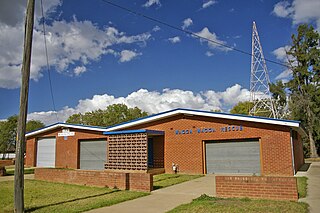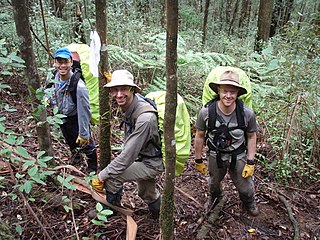
The State Emergency Service (SES) is the name used by a number of volunteer organisations in Australia that provide assistance during and after major incidents. Specifically, the service deals with floods, storms and tsunamis, but can also assist in other emergencies, such as vertical and road crash rescues, missing persons searches, and medical evacuations. In other scenarios the SES may provide a support role to other agencies, particularly police and fire. The SES is operational 24 hours a day. The SES is constituted as separate organisations operating in the various Australian states and territories. Eight of the SES organisations co-ordinate through the Australian Council of State and Territory Emergency Services (ACSES).

The Volunteer Rescue Association Inc (VRA) is an Australian organisation of volunteer members, they provide rescue to the communities across New South Wales. The first rescue squads, with the assistance of NSW Police formed the Volunteer Rescue Association, groups with common charters can become an affiliate of the Association.

The Royal Prince Alfred Hospital is a major public teaching hospital in Sydney, Australia, located on Missenden Road in Camperdown. It is a teaching hospital of the Central Clinical School of the Sydney Medical School at the University of Sydney and is situated in proximity to the Blackburn Building of the university's main campus. RPAH is the largest hospital in the Sydney Local Health District, with approximately 700 beds. Following a $350 million redevelopment, the perinatal hospital King George V Memorial Hospital has been incorporated into it.

The Budawang Range, commonly called The Budawangs, a rugged mountain range within the Budawang National Park and the Morton National Park, are part of a spur off the Great Dividing Range and are located in the South Coast region of New South Wales, Australia.
Responsibilities for traditional coast guard duties in Australia are distributed across various federal, state and community agencies. The de facto coast guard of Australia is the Maritime Border Command, a joint command of the Australian Defence Force and the Australian Border Force which works alongside the Australian Federal Police, the Australian Fisheries Management Authority, and the Australian Maritime Safety Authority. Each state and territory government have specific maritime safety agencies and police marine units. In addition, there are several private volunteer coast guard organisations which act as auxiliary search and rescue services and maritime safety educators with the largest organisations being the Royal Volunteer Coastal Patrol established in 1937, the Australian Volunteer Coast Guard established in 1961, and Marine Rescue New South Wales established in 2009.

The Narrow Neck Plateau, an eroded remnant of a sandstone layer situated at an elevation of 1,000 metres (3,300 ft) above sea level that is part of the Blue Mountains Range which is a spur line off the Great Dividing Range, is situated immediately south-west of Katoomba in New South Wales, Australia, located within the Blue Mountains National Park. The neck separates the Jamison Valley from the Megalong Valley.

The State Protection Group (SPG) is part of the Specialist Operations division of the New South Wales Police Force, having been established in 1991 to deal with extraordinary policing responses. The SPG directly supports police in high-risk incidents such as sieges with specialised tactical, negotiation, intelligence and command-support services. The unit also provides rescue and bomb disposal support, canine policing, and armoury services.

New South Wales Ambulance, an agency of NSW Health, is the statutory provider of pre-hospital emergency care and ambulance services in the state of New South Wales, Australia.

Fire and Rescue NSW, an agency of the Government of New South Wales, Australia, is responsible for firefighting, rescue and hazmat services in the major cities, metropolitan areas and towns across New South Wales. Fire and Rescue NSW is the forth largest urban fire service in the world, with over 6,800 firefighters serving at 335 fire stations throughout the state, supported by 465 administrative and trades staff and 5,700 community fire unit volunteers. FRNSW are also the busiest fire service in Australia, attending over 124,000 incidents a year.
Amateur Radio Emergency Communications (AREC), formerly the Amateur Radio Emergency Corps, is a service provided by the New Zealand Association of Radio Transmitters (NZART) which provides trained radio communicators and communication systems for emergency situations.
The Specialist Operations was a Command within the New South Wales Police Force that was responsible for a range of specialist groups of the police force. The division was headed by the deputy commissioner of the NSW Police, whose position was occupied by Nick Kaldas prior to his retirement.

The New South Wales State Emergency Service, an agency of the Government of New South Wales, is an emergency and rescue service dedicated to assisting the community in times of natural and man-made disasters. The NSW SES is made up almost entirely of volunteer members, numbering over 9,000 as of June 2018. Members are easily identified by their distinctive orange overalls.

Bush Search and Rescue Victoria (BSAR) is a volunteer search and rescue group active in the state of Victoria (Australia) and is affiliated with Bushwalking Victoria. Bush Search and Rescue participates in land-based search and rescue activities for persons lost in the bush, in conjunction with and under direction from the Victoria Police Search and Rescue Squad.
The Australian Aerial Patrol is an aerial observation and support service in New South Wales, Australia. It was formed in 1957 following a meeting convened by the City of Greater Wollongong Council, with a charter to maintain the safety and the welfare of the community through aerial observation and support. The Aerial Patrol is available to respond to emergencies 24 hours a day, 365 days a year.
The Search and Rescue Squad is the Search and Rescue group of the Victoria Police that provides specialist expertise, advice and practical assistance in land search and rescue. This expertise covers most terrains including snow and vertical cliff search and rescue.

The 1981 Barrington Tops Cessna 210 disappearance relates to the mysterious disappearance of a Cessna 210 flying from Whitsunday Coast Airport to Bankstown Airport via Gold Coast Airport. The last known contact with the aircraft was in the Barrington Tops area. Nothing further was heard and no trace of the aircraft or its occupants has so far been found despite extensive searches.
The Bush Club is an Australian bushwalking club founded in 1939 in Sydney, New South Wales by well-known conservationists and bushwalkers Marie Byles and Paddy Pallin. The Bush Club has hundreds of members located in and around Sydney, and is affiliated with Bushwalking NSW, and through them, with Bushwalking Australia.

The Blue Gum Forest is a protected nature reserve located in the Grose Valley of the Blue Mountains, in Blue Mountains National Park, in New South Wales west of Sydney, southeastern Australia. It is one of the best-known bushwalking sites in Australia. As part of the Greater Blue Mountains, the forest is within the UNESCO World Heritage Site. The forest survived through the efforts of early Australian conservationists.












